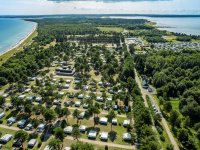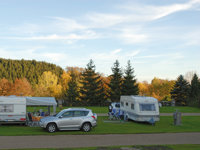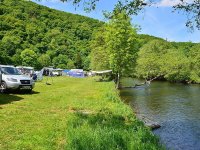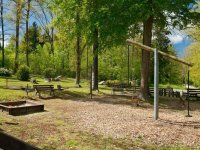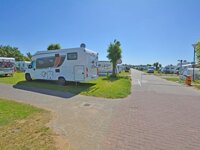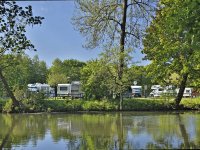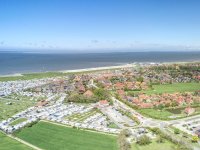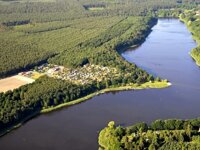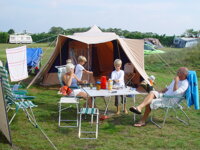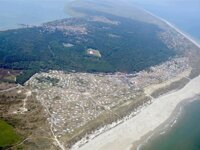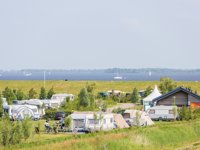
Camping in Denmark, Germany & The Netherlands Dark Sky Reserves
Discover hidden gems in Denmark, Germany & The Netherlands: Dark Sky Camping.
Picture a getaway from the urban rush, where you exchange city lights for starlit skies and lose yourself in the majestic beauty of the cosmos. Dark sky camping presents a unique chance to forge a deep connection with the universe, a rarity in our contemporary lives. Whether you're an avid stargazer or an adventurer craving a novel experience beneath the night canopy, Denmark, Germany, and the Netherlands offer dark-sky camping destinations that guarantee unforgettable moments, leaving you mesmerised by the celestial marvels overhead.
Denmark
Denmark's Dark Sky Places, like Møn and Bulbjerg, offer stunning views of the stars free from light pollution. They're perfect spots for stargazing enthusiasts and anyone who wants to appreciate the beauty of the night sky.
Bulbjerg IDS Park
Bulbjerg Dark Sky Park
Location Jutland, Denmark
Status International Dark Sky Park
Year of Designation 2023
Area 12.5km2
Advocacy efforts by the Hawboernes Association and partners, including Thisted Municipality and Aarhus University, have been pivotal. Offering opportunities for wildlife observation, photography, and hiking, the park serves as a beacon of nocturnal preservation, inspiring similar initiatives across Scandinavia and beyond.
Bulbjerg International Dark Sky Park Campsites
Mandø IDS Park
Mandø
Location Jutland, Denmark
Status International Dark Sky Park
Year of Designation 2024
Area 8.5km2
Mandø, a small island in the Wadden Sea, has embarked on a journey to become an International Dark Sky Park, celebrated for its natural darkness and critical role as a wildlife habitat. Collaborative efforts led by the Mandø Joint Council and supported by various stakeholders have included replacing street lamps with dark sky-friendly lighting and implementing a lighting curfew.
Endorsed by the Danish Minister for the Environment and other stakeholders, the Dark Sky Park initiative underscores the significance of preserving natural darkness on both national and international levels, as highlighted by the Wilhelmshaven Declaration. Despite its modest population, Mandø welcomes over 80,000 tourists annually, offering opportunities for stargazing and educational engagement amidst its pristine landscapes and unique tidal road access.
Mandø International Dark Sky Park Campsites
There is one campsite on the island, Mandø Brugs and Camping, alternatively, stay on the mainland:
Møn and Nyord IDS Park
Møn and Nyord
Location Zealand, Denmark
Status International Dark Sky Park
Year of Designation 2017
Area 11km2
Møn and Nyord, two islands nestled in the Zealand Region of southeastern Denmark, collectively span 223 km2 (86 square miles) of land area. While the larger island of Møn draws significant tourism for its iconic white chalk cliffs, the islands offer a serene escape from the bustle of urban life, boasting open countryside, sandy Baltic Sea beaches, and the charming market town of Stege.
In 2014, residents of Møn initiated efforts to promote the islands' dark skies as a catalyst for economic development and tourism. This led to a joint endeavour to achieve Dark Sky certification, aiming to preserve current nighttime conditions across both developed and wilderness areas of both islands, thereby enhancing their appeal as destinations for stargazers and nature enthusiasts alike.
Møn and Nyord International Dark Sky Park Campsites
There are numerous campsites on the island of Møn, alternatively there are mainland campsites:
Germany
Germany's dark sky spots, like Eifel National Park and Rhön Biosphere Reserve, offer stunning views of the stars away from light pollution. Perfect for stargazing enthusiasts and anyone who appreciates the beauty of the night sky.
Eifel IDS Park
Eifel National Park
Location North Rhine-Westphalia, Germany
Status International Dark Sky Park
Year of Designation 2014
Area 110km2
Eifel National Park, the sole national park in North Rhine-Westphalia, Germany, was established in 2004, covering 110 square kilometres near the Belgian border. Despite being surrounded by densely populated areas, it remains a dark sky oasis amidst urbanisation, presenting a challenge in preserving its pristine night skies.
Eifel International Dark Sky Park Campsites
Fulda IDS Community
Fulda
Location Hesse, Germany
Status International Dark Sky Community (Provisional)
Year of Designation 2019
Area 104km2
Fulda, a key city in Hesse, central Germany, is famed for its baroque architecture and religious heritage dating back to its founding by followers of Saint Boniface. With a modern economy driven by manufacturing, it boasts one of the EU's lowest unemployment rates.
Situated near the western edge of the Rhön International Dark Sky Reserve, Fulda, with a population of around 68,000, has been engaged in discussions since 2014 regarding its outdoor lighting to preserve conditions in the Reserve. Following the Rhön Biosphere Reserve's example, Fulda has secured recognition from the International Dark-Sky Association.
Fulda International Dark Sky Community Campsites
Pellworm Star Island
Pellworm Star Island
Location North Frisian Islands, Germany
Status International Dark Sky Community
Year of Designation 2021
Area 37km2
Pellworm Star Island, nestled within the UNESCO World Heritage Wadden Sea and the German National Park Schleswig-Holsteinisches Wattenmeer, is vital for preserving a significant intertidal ecosystem and serves as a crucial resting spot for millions of coastal birds annually. By minimising artificial light, Pellworm supports bird migration and enhances habitat quality.
Originally settled by Frisians in the 11th century, Pellworm offers a unique holiday experience with opportunities to interact with locals. To bolster sustainable tourism, the island integrates astrotourism into its economy, capitalising on its dark skies.
Pellworm Star Island International Dark Sky Community Campsites
There is one campsite on the island, Wattenmeerhaus Pellworm; alternatively, stay on the mainland:
Rhön IDS Reserve
Rhön
Location Hesse, Bavaria and Thuringia, Germany
Status International Dark Sky Reserve
Year of Designation 2014
Area 1720km2
Established in 1991 by UNESCO, the Rhön Biosphere Reserve covers 1,720 square kilometres of protected lands in the central region of the Rhön Mountains, where Hesse, Bavaria, and Thuringia meet. Reaching elevations of up to 950 meters, the area is known as the "Land of endless horizons".
Its darkest night skies are in the core zone, while responsible outdoor lighting policies in the buffer zone protect them. Unique within the Dark Sky Places Program, the Rhön Dark Sky Reserve's core consists of three distinct, non-contiguous areas: Hohe Geba in the northeast, Lange Rhön in the centre, and Schwarze Berge in the south.
Rhön International Dark Sky Reserve Campsites
Spiekeroog Star Island
Spiekeroog Star Island
Location East Frisian Islands, Germany
Status International Dark Sky Community
Year of Designation 2021
Area 18km2
Spiekeroog Star Island, part of the UNESCO Wadden Sea World Heritage in Lower Saxony's German National Park Niedersächsisches Wattenmeer, exemplifies the area's commitment to reducing light pollution.
As one of Germany's darkest places, it aligns with the Leeuwarden Declaration of 2018, promoting sustainable tourism and preserving the Wadden Sea ecosystem. Serving as a model for other communities, Spiekeroog demonstrates how to minimise unnecessary light emissions while fostering a sustainable coexistence between humans and nature.
Spiekeroog Star Island International Dark Sky Community Campsites
Westhavelland IDS Reserve
Westhavelland
Location Brandenburg, Germany
Status International Dark Sky Reserve
Year of Designation 2014
Area 1380km2
Westhavelland Nature Park, Brandenburg's largest protected area, features Europe's largest contiguous wetland. Just 70 km west of Berlin, its Dark Sky Reserve offers nearly six million people in the Berlin-Brandenburg Metropolitan Region access to pristine night skies.
Covering 750 square kilometres of public and private land within the park, initiatives like the WestHavelländer AstroTreff star party and partnerships with private enterprises promote dark sky conservation and astrotourism.
Westhavelland International Dark Sky Reserve Campsites
Netherlands
The Netherlands offers excellent dark sky locations like Lauwersmeer National Park and the Wadden Sea Islands for stargazing. Minimal light pollution and stunning night views make them perfect for anyone who loves the stars.
De Boschplaat IDS Park
De Boschplaat
Location Terschelling, Netherlands
Status International Dark Sky Park
Year of Designation 2015
Area 40km2
De Boschplaat, a 40 square kilometre area on the eastern side of Terschelling Island, is a "Natura 2000" Nature Reserve recognised by the European Council and locally managed by the Staatsbosbeheer conservation agency.
Except for conservation closures, the public enjoys unrestricted access to the entire property at all times. Additionally, eight locations within the park are specifically designated for nighttime stargazing.
De Boschplaat International Dark Sky Park Campsites
There are a number of camping options on Terschelling Island; alternatively, stay on nearby Vlieland Island or Ameland Island.
Lauwersmeer IDS Park
Lauwersmeer National Park
Location Friesland / Groningen, Netherlands
Status International Dark Sky Park
Year of Designation 2016
Area 60km2
Lauwersmeer National Park, a former underwater area reclaimed in 1969, now thrives as a freshwater lake teeming with diverse plant and animal life. Grazing maintains its open landscape, attracting migratory birds.
Its preservation efforts have kept artificial light minimal, making it a rare oasis of darkness in light-polluted Western Europe, ideal for stargazing.


